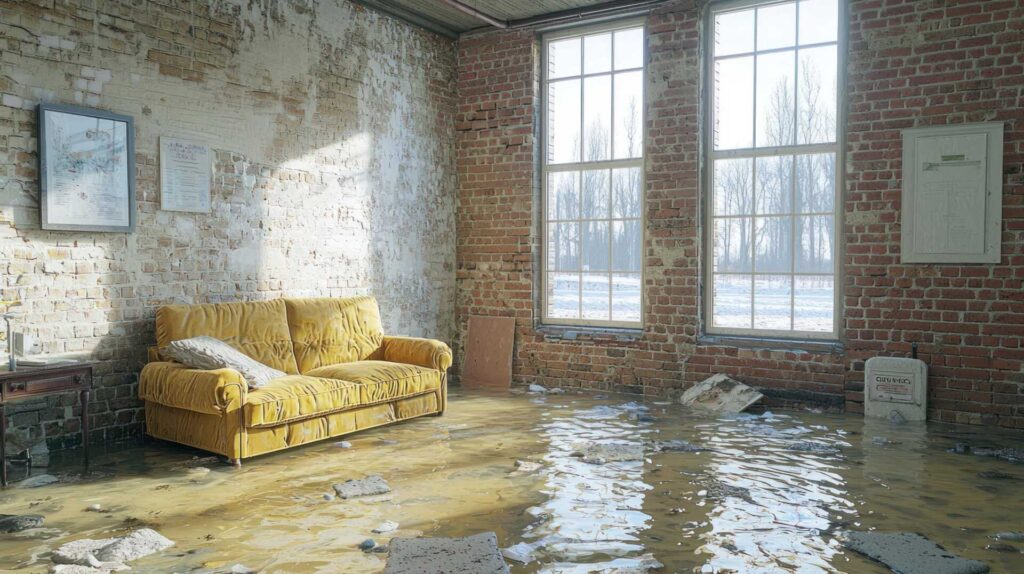
Contents
Maneuvering the aftermath of a flood can feel like wading through a stormy sea with chaos all around. It’s vital to tackle the cleanup process methodically to minimize damage and ensure safety. From evaluating the extent of the damage to properly restoring your home, each step requires careful consideration. As you begin this intimidating task, understanding the best practices can make all the difference in your recovery journey. What’s the first step you should take?
Key Takeaways
- Assess the damage immediately by documenting with photos and checking for structural issues and waterlogged belongings.
- Ensure safety by wearing protective gear and checking for signs of instability before entering the affected area.
- Remove standing water promptly using pumps or vacuums to prevent further damage and health risks.
- Dry and dehumidify affected areas with fans and dehumidifiers to maintain a humidity level of 30-60%.
- Restore and repair damaged structures, consulting professionals for severe issues and using moisture-resistant materials.
Assess the Damage Immediately
As soon as it’s safe to enter your home after a flood, you need to assess the damage thoroughly.
Start by documenting everything with photos or videos—this will support your flood insurance claim. Focus on structural damage, such as cracks in the walls, damaged roofing, or compromised foundations. Check for waterlogged furniture and personal belongings, as they mightn’t be salvageable.
Pay attention to electrical systems and appliances; water damage here can pose serious risks.
Your damage assessment should also include hidden areas like basements and crawl spaces, where mold can develop quickly.
Make a detailed list of everything affected, noting the severity of each item. This record will be invaluable when you reach out to your insurance provider for assistance.
Ensure Safety Before Entering
Before you step back into your home, it’s crucial to ensure the area is safe. Floods can bring hidden dangers, from structural damage to contaminated water.
Start by wearing proper safety gear, including gloves and sturdy boots, to protect yourself from potential hazards. As you approach your home, look for any signs of instability, like sagging floors or walls.
Make sure to follow emergency procedures; this could mean turning off utilities to prevent electrocution or gas leaks before entering. If there are downed power lines or severe structural concerns, consider waiting for professionals to assess the situation.
Once you’re inside, remain vigilant for mold growth and other contaminants.
Remove Standing Water Promptly
Once you’ve confirmed your safety, it’s vital to act quickly to remove standing water from your home.
Standing water can lead to serious damage, mold growth, and health risks, so your prompt action is imperative.
Here’s how you can effectively manage water removal:
Use a Pump: If the flooding is significant, consider using a submersible pump to remove large volumes of water quickly.
Utilize Wet/Dry Vacuums: For smaller amounts, a wet/dry vacuum can be very effective. Make sure to wear appropriate gear while doing this.
Mop and Towels: After using a vacuum, mop the remaining water and soak up any excess with towels to ensure no moisture lingers.
Dry and Dehumidify Affected Areas
To effectively restore your home after flooding, drying and dehumidifying affected areas is essential.
Start by using high-powered fans to circulate air and speed up evaporation. For best results, consider your dehumidifier selection carefully; choose a unit that suits the size of the space and can handle the moisture level in your home. Aim for a dehumidifier that can extract enough water per day to combat the excess humidity.
While dehumidifying, implement moisture monitoring techniques. Use hygrometers to track humidity levels, ensuring you reach and maintain a safe range of 30-60%. This prevents mold growth and further damage.
Stay vigilant and check regularly, as lingering moisture can lead to significant issues.
Restore and Repair Damaged Structures
As you begin to restore and repair damaged structures after a flood, it’s vital to assess the extent of the damage before diving into repairs.
Understanding the impact on your home’s structural integrity will guide your next steps. Here are three key repair techniques to take into account:
Inspect and Document: Check for signs of structural weakness—cracks, warped floors, or compromised walls—and document everything for insurance purposes.
Consult Professionals: Depending on the damage’s severity, hiring structural engineers or contractors may be necessary to ensure safe and effective repairs.
Use Quality Materials: When making repairs, choose high-quality materials that can withstand moisture and prevent future damage.
This is critical for restoring your home’s durability.
Wrap-Up
Taking swift action after flood damage is essential for minimizing loss and ensuring safety. For instance, a family in Texas documented their damage promptly and removed water within hours, preventing mold growth and saving thousands in repairs. By following these cleanup tips, you can protect your home and investments effectively. Remember, being proactive safeguards your property and gives you peace of mind during a stressful time.
Recent Posts
What Are Effective Basement Water Removal Solutions?
Basement Water Removal is crucial to preventing structural damage and hazardous mold growth. Acting quickly
Why Choose 24/7 Burst Pipe Repair Services?
Is it true that plumbing emergencies can escalate quickly, causing significant damage if not addressed
Quick Guide to 24/7 Burst Pipe Repair
When a pipe bursts, immediate burst pipe repair action is crucial to prevent extensive damage.